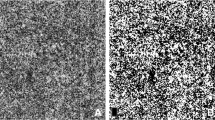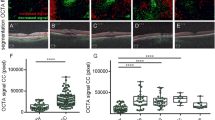Abstract
Purpose
To quantitatively analyze characteristics of choriocapillaris flow using spectral domain optical coherence tomography angiography (SD-OCTA) in eyes with chronic central serous chorioretinopathy (CSC) before and after treatment by photodynamic therapy (PDT).
Methods
Retrospective interventional study. Macular 3X3 SD-OCT scans were analyzed in eyes diagnosed with chronic CSC before and after treatment with half-fluence PDT. The choriocapillaris en face slabs were extracted from the SD-OCTA device after manual segmentation. En face choriocapillaris flow images were compensated with en face choriocapillaris structure images. Phansalkar local thresholding method was then used with a radius of 4 and 8 pixels. Percentage of flow deficits (FD%), number, size, and total area of FDs were computed for comparison, before and after treatment by half-fluence PDT.
Results
Mean choriocapillaris FD% before PDT was of 58.36 + / − 11.88 and of 60.82 + / − 11.08 after PDT using radius 4 pixels with no significant difference (p = 0.140). Mean choriocapillaris FD% was of 58.63 + / − 11.08 before PDT and of 60.87 + / − 10.36 after PDT using radius 8 pixels with no significant difference (p = 0.200). Similarly, no significative difference was found in number, size, and total area of FDs, before and after half-fluence PDT, using radius 4 and 8 pixels in patients with chronic CSC.
Conclusion
Using Phansalkar local thresholding method, quantitative analysis of choriocapillaris with SD-OCTA found no significant change in choriocapillaris flow deficits before and after successful half-fluence PDT in patients with chronic CSC. Therefore, it seems that half-fluence PDT may not alter choriocapillaris perfusion, at least on a relative short-term basis.




Similar content being viewed by others
Data availability
Yes.
Code availability
Not applicable.
Change history
30 April 2022
A Correction to this paper has been published: https://doi.org/10.1007/s00417-022-05677-8
References
Yannuzzi LA, Shakin JL, Fisher YL, Altomonte MA (1984) Peripheral retinal detachments and retinal pigment epithelial atrophic tracts secondary to central serous pigment epitheliopathy. Ophthalmology 91:1554–1572
Dansingani KK, Balaratnasingam C, Naysan J, Freund KB (2016) En face imaging of pachychoroid spectrum disorders with swept-source optical coherence tomography. Retina 36(3):499–516
Gallego-Pinazo R, Dolz-Marco R, Gomez-Ulla F et al (2014) Pachychoroid diseases of the macula. Med Hypothesis Discov Innov Ophthalmol 3:111–115
Cheung CMG, Lee WK, Koizumi H et al (2019) Pachychoroid disease. Eye (Lond) 33(1):14–33
Nicholson B, Noble J, Forooghian F, Meyerle C (2013) Central serous chorioretinopathy: update on pathophysiology and treatment. Surv Ophthalmol 58(2):103–126
van Rijssen TJ, van Dijk EHC, Yzer S et al (2019) Central serous chorioretinopathy: towards an evidence-based treatment guideline. Prog Retin Eye Res 73:100770
Costanzo E, Cohen SY, Miere A et al (2015) Optical coherence tomography angiography in central serous chorioretinopathy. J Ophthalmol 2015:134783
Teussink MM, Breukink MB, van Grinsven MJ et al (2015) OCT angiography compared to fluorescein and indocyanine green angiography in chronic central serous chorioretinopathy. Invest Ophthalmol Vis Sci 56:5229–5237
Shinojima A, Kawamura A, Mori R et al (2016) Findings of optical coherence tomographic angiography at the choriocapillaris level in central serous chorioretinopathy. Ophthalmologica 236:108–113
Fujita K, Kawamura A, Yuzawa M (2017) Choriocapillaris changes imaged by OCT angiography after half-dose photodynamic therapy for chronic central serous chorioretinopathy. Ophthalmic Surg Lasers Imaging Retina 48(4):302–310
Cennamo G, Cennamo M, Caputo G et al (2019) Optical coherence tomography angiography to assess vascular remodeling of the choriocapillaris after low-fluence photodynamic therapy for chronic central serous chorioretinopathy. Photodiagnosis Photodyn Ther 27:162–166
Demirel S, Özcan G, Yanık Ö et al (2019) Vascular and structural alterations of the choroid evaluated by optical coherence tomography angiography and optical coherence tomography after half-fluence photodynamic therapy in chronic central serous chorioretinopathy. Graefes Arch Clin Exp Ophthalmol 257(5):905–912
Yang HS, Kang TG, Park H et al (2020) Quantitative evaluation of choriocapillaris using optical coherence tomography and optical coherence tomography angiography in patients with central serous chorioretinopathy after half-dose photodynamic therapy. PLoS One 15(1):e0227718
Chu Z, Gregori G, Rosenfeld PJ, Wang RK (2019) Quantification of choriocapillaris with optical coherence tomography angiography: a comparison study. Am J Ophthalmol 208:111–123
Borrelli E, Shi Y, Uji A et al (2018) Topographic analysis of the choriocapillaris in intermediate age-related macular degeneration. Am J Ophthalmol 196:34–43
Zhang Q, Zheng F, Motulsky EH et al (2018) A novel strategy for quantifying choriocapillaris flow voids using swept-source OCT angiography. Invest Ophthalmol Vis Sci 59(1):203–211
Gal-Or O, Dansingani KK, Sebrow D et al (2018) Inner choroidal flow signal attenuation in pachychoroid disease: optical coherence tomography angiography. Retina 38(10):1984–1992
Schmidt-Erfurth U, Laqua H, Schlötzer-Schrehard U et al (2002) Histopathological changes following photodynamic therapy in human eyes. Arch Ophthalmol 120(6):835–844
Xu Y, Su Y, Li L et al (2017) Effect of photodynamic therapy on optical coherence tomography angiography in eyes with chronic central serous chorioretinopathy. Ophthalmologica 237(3):167–172
Borrelli E, Souied EH, Freund KB et al (2018) Reduced choriocapillaris flow in eyes with type 3 neovascularization and age-related macular degeneration. Retina 38(10):1968–1976
Le HM, Souied EH, Querques G et al (2021) Choriocapillaris flow impairment in type 3 macular neovascularization: a quantitative analysis using swept-source optical coherence tomography angiography. Retina 41(9):1819–1827
Lane M, Moult EM, Novais EA et al (2016) Visualizing the choriocapillaris under drusen: comparing 1050-nm swept-source versus 840-nm spectral-domain optical coherence tomography angiography. Investig Ophthalmol Vis Sci. 57(9):OCT585–OCT590
Funding
This study is supported by an unrestricted grant from CIL-ASSOC (Paris, France), an association for research and education. The funding organization had no role in the design or conduct of this research.
Author information
Authors and Affiliations
Contributions
Conceptualization: Salomon Y Cohen; Methodology: HoangMai Le, Salomon Y Cohen, Sarah Mrejen; Formal analysis and investigation: HoangMai Le, Lise Sibilia; Writing—original draft preparation: HoangMai Le; Writing—review and editing: Salomon Y Cohen, Sarah Mrejen; Funding acquisition: Salomon Y Cohen.
Corresponding author
Ethics declarations
Ethics approval
Approval was given by the Independent Review Board/Ethical Committee of the Federation France Macula.
Consent to participate
Not applicable (retrospective study).
Consent for publication
Not applicable (retrospective study).
Conflict of interest
Dr Le and Mrs Sibilia have no financial interest to declare. Dr Mrejen is consultant for Bayer and Novartis. Dr Cohen is consultant for Allergan, Bayer, Novartis, Roche, and Thea.
Additional information
Publisher's note
Springer Nature remains neutral with regard to jurisdictional claims in published maps and institutional affiliations.
The original version of this article was revised. Figure 1 is now corrected.
Rights and permissions
About this article
Cite this article
Le, H.M., Mrejen, S., Sibilia, L. et al. Optical coherence tomography angiography quantification of choriocapillaris blood-flow after half-fluence photodynamic therapy for chronic central serous chorioretinopathy. Graefes Arch Clin Exp Ophthalmol 260, 2483–2490 (2022). https://doi.org/10.1007/s00417-022-05637-2
Received:
Revised:
Accepted:
Published:
Issue Date:
DOI: https://doi.org/10.1007/s00417-022-05637-2




